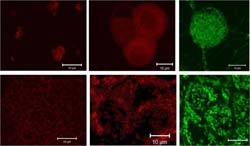Double the pain: RUB biologists find the cause of pain in the treatment of fair skin cancer

Cells that are incubated with aminolevulinic acid form protoporphyrin IX (PpIX), which appears red on the fluorescence micrograph. Both nerve cells (top row), and skin cancer cells (bottom row) form PpIX. The image on the left of both rows represents an overview, the images in the middle and on the right show enlarged sections of the images on the left. The power plants of the nerve and cancer cells, the mitochondria, are coloured green. The colour pattern of PpIX and the mitochondrial dye are similar. This suggests that PpIX accumulates in the mitochondria. Image: Ben Novak<br>
Apply the ointment, light on, light off – that’s how easy it is to cure various forms of non-melanoma skin cancer.
However, the majority of patients suffer severe pain during the so-termed photodynamic therapy. Why the treatment with ointment and red light can be so painful has now been uncovered by researchers from the RUB.
They identified the ion channels involved and signalling molecules secreted by the cancer cells. “The results may provide a starting point for suppressing the pain”, says Dr. Ben Novak of the Department of Animal Physiology.
How the photodynamic therapy works
In contrast to normal cells, cancer cells are equipped with different enzymes and have a much higher metabolism. If you apply a molecule called aminolevulinic acid to the skin in the form of a gel, cancer cells take up considerably more of this substance than healthy cells. If aminolevulinic acid accumulates in the cells, the mitochondria – the power plants of the cells – form the molecule protoporphyrin IX. When irradiated with red light, protoporphyrin IX reacts with oxygen. This produces highly reactive oxygen species, free radicals, which destroy the cancer cells. Approximately ten minutes of red light irradiation is sufficient to successfully treat superficial forms of non-melanoma skin cancers such as actinic keratosis. Doctors also remove warts in this way.
Painful therapy
“The catch is: it’s terribly painful”, says Ben Novak. Forty percent of those treated experience pain during the light irradiation, which they assess on a scale of 0 to 10 (whereby 10 corresponds to an excruciating pain like a heart attack) as 7 to 8. Using injections, like at the dentist, it is possible to numb the nerves involved. “But that also always involves a risk”, says the Bochum biologist. The scientists led by the RUB professor Dr. Hermann Lübbert have now solved the mystery as to why the treatment hurts at all.
Pain-sensitive cells in the skin are stimulated
The pain is generated by two mechanisms. In a cell culture experiment, the team showed that not only cancer cells but also pain-sensitive nerve cells in the skin take up aminolevulinic acid – and its derivative methyl aminolevulinic acid – from the ointment. Using calcium imaging, the animal physiologists followed the activity of nerve cells which they had treated with aminolevulinic acid and cells that were not exposed to the substance. Treated nerve cells fired when the researchers exposed them to light. In a living organism, this would mean that the cells would send a pain stimulus to the brain. Without the aminolevulinic acid, the pain-sensitive cells remained inactive under red light. In further experiments, the scientists showed that the activity of the nerve cells is caused by sodium channels and voltage-gated calcium channels in the cell membrane. “A drug that targets these channels would, conceivably, be able to suppress the pain – but that’s still in the future”, says Ben Novak.
Tumour cells alert nerve cells
Lübbert’s team found that pain is generated in the nerve cells themselves, but also in another way. The affected tumour cells secrete a molecule – namely acetylcholine. “This is how they pass the message to other cells: something is wrong, my mitochondria are collapsing right now”, Novak illustrates. Acetylcholine acts as a neurotransmitter in the nervous system, where it is harmless. “Previous studies have shown though, that it is very painful when it is injected into the skin”. Some of the results have already been published. The researchers are currently preparing the data on the mechanisms of pain generation for publication. This attracted a great deal of interest at the 12th Congress of the European Society for Photodynamic Therapy in Dermatology (Euro-PDT) in Copenhagen in May 2012.
Bibliographic record
B. Novak, R. Schulten, H. Lübbert (2011): δ-Aminolevulinic acid and its methyl ester induce the formation of Protoporphyrin IX in cultured sensory neurons, Naunyn-Schmiedeberg's Archives of Pharmacology, doi: 10.1007/s00210-011-0683-1
Further information
Dr. Ben Novak, Department of Animal Physiology, Faculty of Biology and Biotechnology at the Ruhr-Universität, 44780 Bochum, Germany, Tel. +49/234/32-24331
Ben.Novak@rub.de
Prof. Dr. Hermann Lübbert Department of Animal Physiology, Faculty of Biology and Biotechnology at the Ruhr-Universität, 44780 Bochum, Germany, Tel. +49/234/32-24324
Hermann.Luebbert@rub.de
Editor: Dr. Julia Weiler
Media Contact
More Information:
http://www.ruhr-uni-bochum.deAll latest news from the category: Life Sciences and Chemistry
Articles and reports from the Life Sciences and chemistry area deal with applied and basic research into modern biology, chemistry and human medicine.
Valuable information can be found on a range of life sciences fields including bacteriology, biochemistry, bionics, bioinformatics, biophysics, biotechnology, genetics, geobotany, human biology, marine biology, microbiology, molecular biology, cellular biology, zoology, bioinorganic chemistry, microchemistry and environmental chemistry.
Newest articles

Innovative 3D printed scaffolds offer new hope for bone healing
Researchers at the Institute for Bioengineering of Catalonia have developed novel 3D printed PLA-CaP scaffolds that promote blood vessel formation, ensuring better healing and regeneration of bone tissue. Bone is…

The surprising role of gut infection in Alzheimer’s disease
ASU- and Banner Alzheimer’s Institute-led study implicates link between a common virus and the disease, which travels from the gut to the brain and may be a target for antiviral…

Molecular gardening: New enzymes discovered for protein modification pruning
How deubiquitinases USP53 and USP54 cleave long polyubiquitin chains and how the former is linked to liver disease in children. Deubiquitinases (DUBs) are enzymes used by cells to trim protein…



